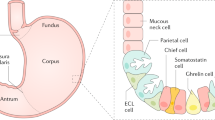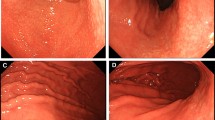Abstract
Chronic atrophic corpus gastritis, termed as autoimmune corpus gastritis or type A gastritis, and primary biliary cirrhosis (PBC) are characterized by a common immunological process against the exocrine glandular structures of both the stomach and bile duct. However, there has been controversy over whether atrophic corpus gastritis is associated with PBC. Recently, it has been suggested that Helicobacter pylori plays an important role in the early stage of atrophic corpus gastritis due to the induction of autoantibodies that are reactive with a protein in the gastric parietal cells. One hypothesis is that molecular mimicry, possibly resulting from H. pylori infection, might be responsible for initiating an autoimmune response in a predisposed host due to cross-reactivity among gastric mucosal, bile ductular, and bacterial antigens. The aim of this study is to assess whether atrophic changes of the gastric corpus could affect patients with PBC, and to determine the correlation with H. pylori infection. Sixteen patients with PBC were enrolled in this study. All patients were examined by serological studies of anti-pyruvate dehydrogenase (PDH) antibody, anti-H. pylori antibody, gastrin and vitamin B12. Gastroscopy was performed on all patients in order to verify the histological findings and to microscopically identify H. pylori. Atrophic corpus gastritis was found in 2 of 16 patients with PBC (12.5%), one of whom was confirmed to have pernicious anemia, a developed stage of atrophic corpus gastritis. H. pylori infection in the gastric corpus and the anti-H. pylori antibody were found in 7 (43.8%) and 11 (68.8%) of 16 patients, respectively. Anti-H. pylori antibody was confirmed to be positive in both of the patients with atrophic corpus gastritis, although H. pylori was absent in the gastric biopsy specimen. There was a positive correlation between anti-PDH antibodies and anti-H. pylori antibodies in sera from patients with PBC. Atrophic corpus gastritis is not frequently involved in PBC. However, H. pylori is a possible pathogenic factor in atrophic corpus gastritis in PBC patients because of the presence of anti-H. pylori antibody. A positive correlation between the titer of anti-PDH antibodies and the titer of anti-H. pylori antibodies was confirmed. Consequently, H. pylori infection could induce autoimmune responses in the development of both PBC and atrophic corpus gastritis. H. pylori infection associated with PBC requires further study.
Similar content being viewed by others
REFERENCES
Culp KS, Fleming CR, Duffy J, Baldus WP, Dickson ER: Autoimmune associations in primary biliary cirrhosis. Mayo Clin Proc 57:365–370, 1982
Sherlock S, Dooley J: Primary biliary cirrhosis. In Diseases of the liver and biliary System, 10th ed. Oxford, Blackwell Scientific Publications, 1997, pp. 239–252
Renoux M, Beaugrand M, Lévy VG, Bernard J-F, Boivin P: Cirrhrose biliaire primitive et anémie de biermer. Une association fortuite? Gastroenterol Clin Biol 4:109–113, 1980
Arikan E, Sayali E, Aydin H, Çelebi A, Canbakan IB: Perniziöse Anämie bei einer Patientin mit primärer biliärer Zirrhose. Wien Med Wocherschr 144:426–428, 1994
Mörk H, Jakob F, Al-Taie O, Gassel AM, Scheurlen M: Primary biliary cirrhosis and gastric carcinoid: A rare association? J Clin Gastroenterol 24:270–273, 1997
Dohmen K, Nagai Y, Matsuishi E, Miyamoto Y, Sasatomi E, Irie K, Ishibashi H: A case of primary biliary cirrhosis associated with pernicious anemia. Jpn J Gastroenterol 96:545–549, 1999
Wakabayashi T, Ohno H, Hayakawa Y, Kawashima A, Sawabu N: Primary biliary cirrhosis associated with type A gastritis and chronic thyroiditis. J Gastroenterol 34:415–419, 1999
Wirth HP, Meyenberger C, Ammann R, Blum HE: Parietalzellantikö rper bei primär biliärer Zirrhose: Pathogenetische oder diagnostische Bedeutung? Schweiz Med Wochenschr 124:816–820, 1994
Oya H, Uchida Y, Nishioka M: Atrophic gastritis in patients with autoimmune liver disease. Gastroenterol Endosc 36:286–295, 1994
Floreani A, Biagini MR, Zappalà F, Farinati F, Plebani M, Rugge M, Surrenti C, Naccarato R: Chronic atrophic gastritis and Helicobacter pylori infection in primary biliary cirrhosis: A cross-sectional study with matching. Ital J Gastroenterol Hepatol 29:13–17, 1997
Varis O, Valle J, Siurala M: Is Helicobacter pylori involved in the pathogenesis of the gastritis characteristic of pernicious anaemia? Comparison between pernicious anaemia relatives and duodenal ulcer relatives. Scand J Gastroenterol 28:705–708, 1993
Ma J-Y, Borch K, Sjöstrand SE, Janzon L, Mårdh S: Positive correlation between H,K-adenosine triphosphatase autoantibodies and Helicobacter pylori antibodies in patients with pernicious anemia. Scand J Gastroenterol 29:961–965, 1994
Claeys D, Faller G, Appelmelk BJ, Negrini R, Kirchner T: The gastric H+, K+-ATPase is a major autoantigen in chronic Helicobacter pylori gastritis with body mucosa atrophy. Gastroenterology 115:340–347, 1998
Appelmelk BJ, Faller G, Claeys D, Kirchner T, Vandenbroucke-Grauls CMJE: Bugs on trial: The case of Helicobacter pylori and autoimmunity. Trends Immunol Today 19:296–299, 1998
Nilsson H-O, Taneera J, Castedal M, Glatz E, Olsson R, Wandström T: Identification of Helicobacter pylori and other Helicobacter species by PCR, hybridization, and partial DNA sequencing in human liver samples from patients with primary sclerosing cholangitis or primary biliary cirrhosis. J Clin Microbiol 38:1072–1076, 2000
Cover TL, Blaser MJ: Purification and characterization of the vacuolating toxin from Helicobacter pylori. J Biol Chem 267:10570–10575, 1992
Song Y-H, Ma J-Y, Mårdh S, Liu T, Sjöstrand SE, Rask L, Borch K, Huang G-C, Barnett P, McGregor AM, Banga JP: Localization of a pernicious anaemia autoantibody epitope on the ?-subunit of human H,K-adenosine triphosphatase. Scand J Gastroenterol 29:122–127, 1994
Dixon MF, Genta RM, Yardley JH, Correa P: Classification and grading of gastritis. The Updated Sydney System 20:1161–1181, 1996
Strickland RG, Mackay IR: A reappraisal of the nature and significance of chronic atrophic gastritis. Am J Dig Dis 18:426–440, 1973
Neufeld M, Maclaren NK, Blizzard RM: Two types of autoimmune Addison's disease associated with different polyglandular autoimmune (PGA) syndromes. Medicine 60:355–362, 1981
Kaye MD: Immunological aspects of gastritis and pernicious anaemia. Ballière's Clinical Gastroenterol 1:487–506, 1987
Negrini R, Lisato L, Zanella I, Cavazzini L, Gullini S, Villanacci V, Poiesi C, Albertini A, Ghielmi S: Helicobacter pylori infection induces antibodies cross-reacting with human gastric mucosa. Gastroenterology 101:437–445, 1991
Flejou J-F, Bahame P, Smith AC, Stockbrugger RW, Rode J, Price AB: Pernicious anaemia and Campylobacter like organisms; Is the gastric antrum resistant to colonisation? Gut 30:60–64, 1989
Fong TL, Dooley CP, Dehesa M, Cohen H, Carmel R, Fitzgibbons PL, Perez-Perez GI, Blaser MJ: Helicobacter pylori infection in pernicious anemia: A prospective controlled study. Gastroenterology 100:328–332, 1991
Butler P, Hamilton-Miller J, Baum H, Burroughs AK: Detection of M2 antibodies in patients with recurrent urinary tract infection using an ELISA and purified PBC specific antigens. Evidence for a molecular mimicry mechanism in the pathogenesis of primary biliary cirrhosis? Biochem Mol Biol Int 35:473–485, 1995
Lin T-T, Yeh C-T, Wu C-S, Liaw Y-F: Detection and partial sequence analysis of Helicobacter pylori DNA in the bile samples. Dig Dis Sci 40: 2214–2219, 1995
Kawaguchi M, Saito T, Ohno H, Midorikawa S, Sanji T, Handa Y, Morita S, Yoshida H, Tsurui M, Misaka R, Hirota T, Saito M, Minami K: Bacteria closely resembling Helicobacter pylori detected immunohistologically and genetically in resected gallbladder mucosa. J Gastroenterol 31:294–298, 1996
Harada N, Dohmen K, Itoh H, Ohshima T, Yamamoto H, Nagano M, Iwata Y, Hachisuka K, Ishibashi H: Sibling cases of primary biliary cirrhosis associated with polymyositis, vasculitis and Hashimoto's thyroiditis. Intern Med 31:289–293, 1992
Becke-Müller S, Kühn H, Stadelmann O: Seltene Kombination von zwei Autoimmunerkrankungen (Sklerodermie, primä r-biliäre Zirrhose) in Verbindung mit Belegzellantikörpern. Leber Magen Darm 4:170–172, 1991
Loffeld BCAJ, van Spreeuwel JP: The gastrointestinal tract in pernicious anemia. Dig Dis 9:70–77, 1991
Epstein O, Thomas HC, Sherlock S: Primary biliary cirrhosis is a dry gland syndrome with features of chronic graft-versus-host disease. Lancet 31:1166–1167, 1980
Author information
Authors and Affiliations
Rights and permissions
About this article
Cite this article
Dohmen, K., Shigematsu, H., Miyamoto, Y. et al. Atrophic Corpus Gastritis and Helicobacter pylori Infection in Primary Biliary Cirrhosis. Dig Dis Sci 47, 162–169 (2002). https://doi.org/10.1023/A:1013292210036
Issue Date:
DOI: https://doi.org/10.1023/A:1013292210036




